Potential Measures to Reduce Emission from Ships
VerifiedAdded on 2023/03/29
|9
|3458
|49
AI Summary
This document discusses the potential measures to reduce emissions from ships, focusing on the reduction of NOx and SOx emissions. It explores technologies like the humid air method and sulphur scrubber system that can help in controlling these emissions. The document also covers the aim, objectives, scope, and organization of the dissertation on this topic.
Contribute Materials
Your contribution can guide someone’s learning journey. Share your
documents today.
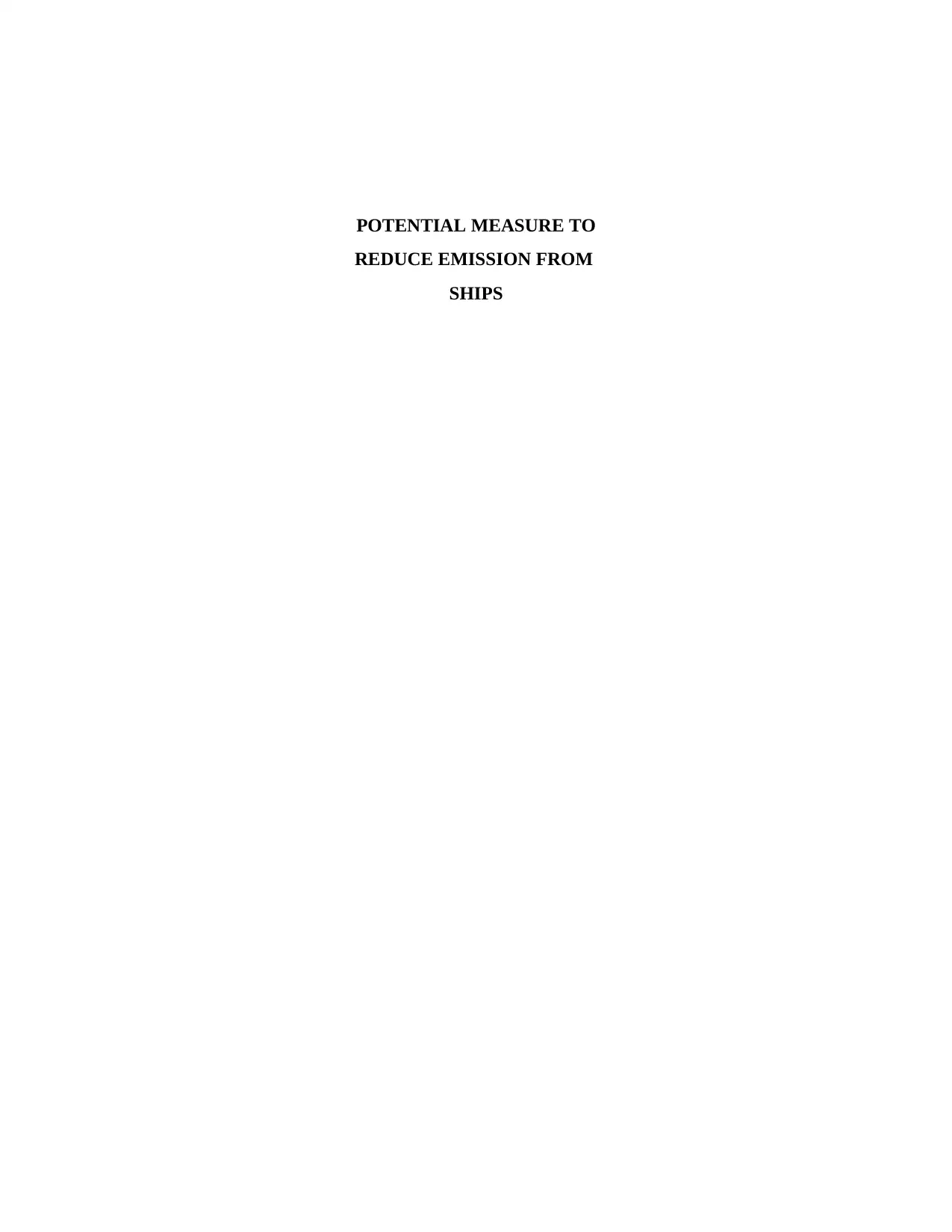
POTENTIAL MEASURE TO
REDUCE EMISSION FROM
SHIPS
REDUCE EMISSION FROM
SHIPS
Secure Best Marks with AI Grader
Need help grading? Try our AI Grader for instant feedback on your assignments.
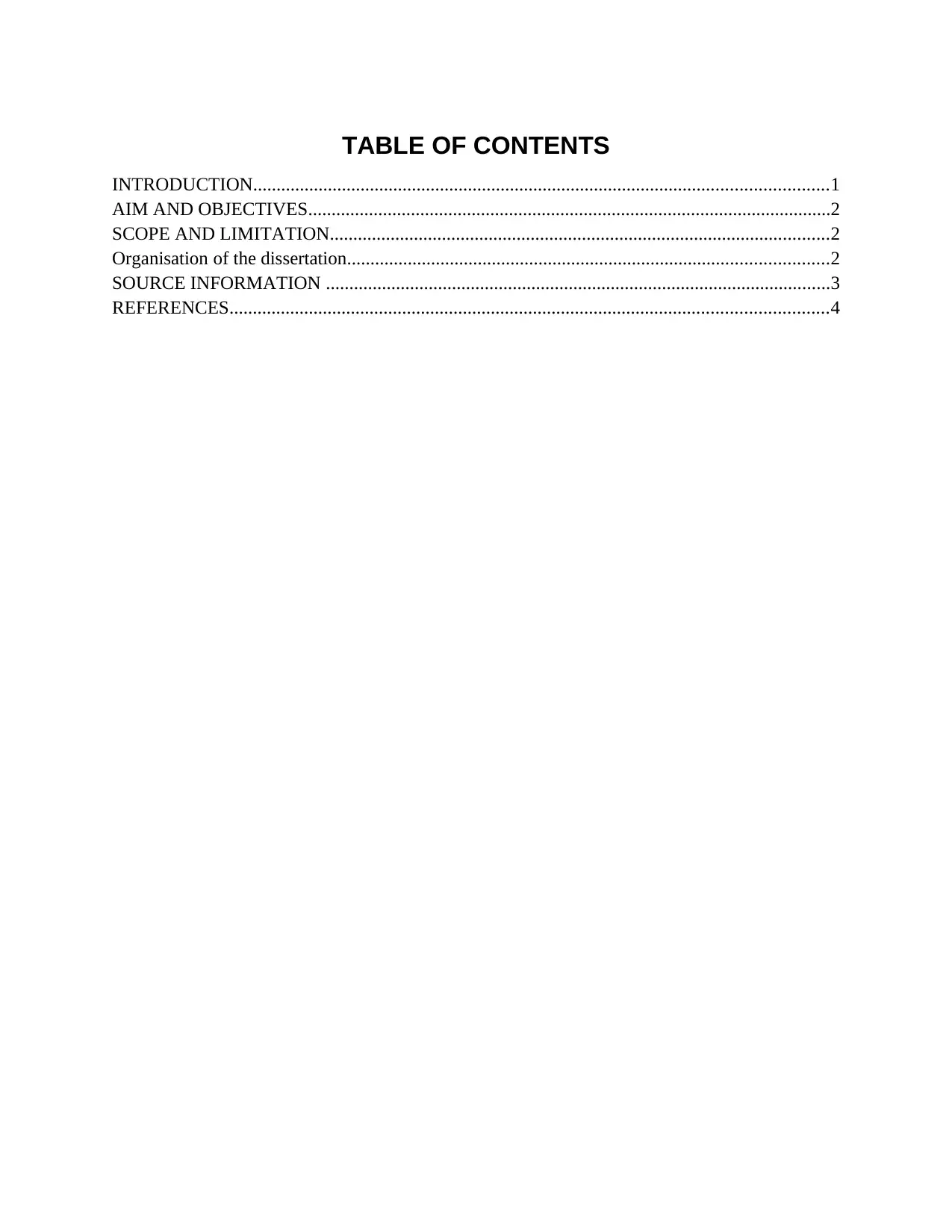
TABLE OF CONTENTS
INTRODUCTION...........................................................................................................................1
AIM AND OBJECTIVES................................................................................................................2
SCOPE AND LIMITATION...........................................................................................................2
Organisation of the dissertation.......................................................................................................2
SOURCE INFORMATION ............................................................................................................3
REFERENCES................................................................................................................................4
INTRODUCTION...........................................................................................................................1
AIM AND OBJECTIVES................................................................................................................2
SCOPE AND LIMITATION...........................................................................................................2
Organisation of the dissertation.......................................................................................................2
SOURCE INFORMATION ............................................................................................................3
REFERENCES................................................................................................................................4
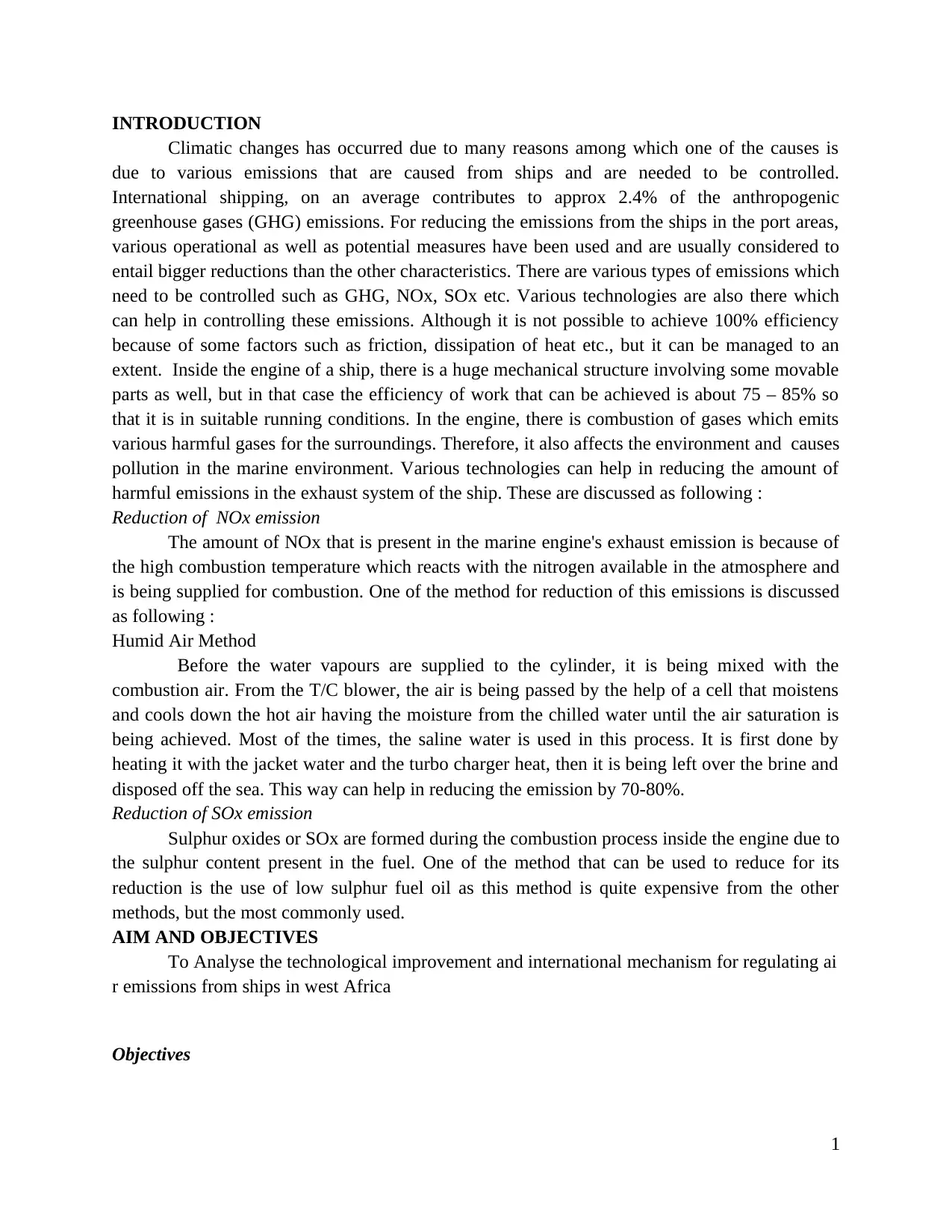
INTRODUCTION
Climatic changes has occurred due to many reasons among which one of the causes is
due to various emissions that are caused from ships and are needed to be controlled.
International shipping, on an average contributes to approx 2.4% of the anthropogenic
greenhouse gases (GHG) emissions. For reducing the emissions from the ships in the port areas,
various operational as well as potential measures have been used and are usually considered to
entail bigger reductions than the other characteristics. There are various types of emissions which
need to be controlled such as GHG, NOx, SOx etc. Various technologies are also there which
can help in controlling these emissions. Although it is not possible to achieve 100% efficiency
because of some factors such as friction, dissipation of heat etc., but it can be managed to an
extent. Inside the engine of a ship, there is a huge mechanical structure involving some movable
parts as well, but in that case the efficiency of work that can be achieved is about 75 – 85% so
that it is in suitable running conditions. In the engine, there is combustion of gases which emits
various harmful gases for the surroundings. Therefore, it also affects the environment and causes
pollution in the marine environment. Various technologies can help in reducing the amount of
harmful emissions in the exhaust system of the ship. These are discussed as following :
Reduction of NOx emission
The amount of NOx that is present in the marine engine's exhaust emission is because of
the high combustion temperature which reacts with the nitrogen available in the atmosphere and
is being supplied for combustion. One of the method for reduction of this emissions is discussed
as following :
Humid Air Method
Before the water vapours are supplied to the cylinder, it is being mixed with the
combustion air. From the T/C blower, the air is being passed by the help of a cell that moistens
and cools down the hot air having the moisture from the chilled water until the air saturation is
being achieved. Most of the times, the saline water is used in this process. It is first done by
heating it with the jacket water and the turbo charger heat, then it is being left over the brine and
disposed off the sea. This way can help in reducing the emission by 70-80%.
Reduction of SOx emission
Sulphur oxides or SOx are formed during the combustion process inside the engine due to
the sulphur content present in the fuel. One of the method that can be used to reduce for its
reduction is the use of low sulphur fuel oil as this method is quite expensive from the other
methods, but the most commonly used.
AIM AND OBJECTIVES
To Analyse the technological improvement and international mechanism for regulating ai
r emissions from ships in west Africa
Objectives
1
Climatic changes has occurred due to many reasons among which one of the causes is
due to various emissions that are caused from ships and are needed to be controlled.
International shipping, on an average contributes to approx 2.4% of the anthropogenic
greenhouse gases (GHG) emissions. For reducing the emissions from the ships in the port areas,
various operational as well as potential measures have been used and are usually considered to
entail bigger reductions than the other characteristics. There are various types of emissions which
need to be controlled such as GHG, NOx, SOx etc. Various technologies are also there which
can help in controlling these emissions. Although it is not possible to achieve 100% efficiency
because of some factors such as friction, dissipation of heat etc., but it can be managed to an
extent. Inside the engine of a ship, there is a huge mechanical structure involving some movable
parts as well, but in that case the efficiency of work that can be achieved is about 75 – 85% so
that it is in suitable running conditions. In the engine, there is combustion of gases which emits
various harmful gases for the surroundings. Therefore, it also affects the environment and causes
pollution in the marine environment. Various technologies can help in reducing the amount of
harmful emissions in the exhaust system of the ship. These are discussed as following :
Reduction of NOx emission
The amount of NOx that is present in the marine engine's exhaust emission is because of
the high combustion temperature which reacts with the nitrogen available in the atmosphere and
is being supplied for combustion. One of the method for reduction of this emissions is discussed
as following :
Humid Air Method
Before the water vapours are supplied to the cylinder, it is being mixed with the
combustion air. From the T/C blower, the air is being passed by the help of a cell that moistens
and cools down the hot air having the moisture from the chilled water until the air saturation is
being achieved. Most of the times, the saline water is used in this process. It is first done by
heating it with the jacket water and the turbo charger heat, then it is being left over the brine and
disposed off the sea. This way can help in reducing the emission by 70-80%.
Reduction of SOx emission
Sulphur oxides or SOx are formed during the combustion process inside the engine due to
the sulphur content present in the fuel. One of the method that can be used to reduce for its
reduction is the use of low sulphur fuel oil as this method is quite expensive from the other
methods, but the most commonly used.
AIM AND OBJECTIVES
To Analyse the technological improvement and international mechanism for regulating ai
r emissions from ships in west Africa
Objectives
1
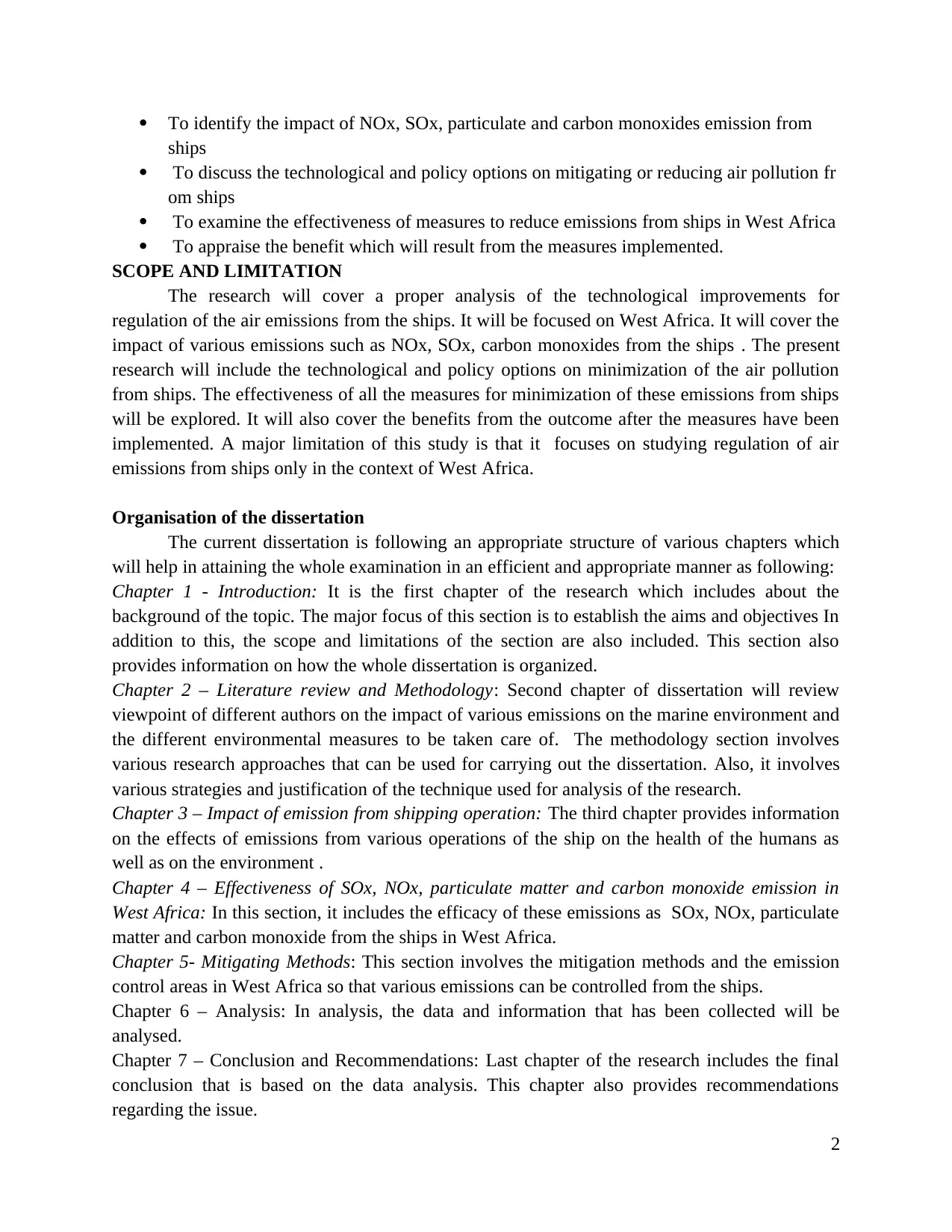
To identify the impact of NOx, SOx, particulate and carbon monoxides emission from
ships
To discuss the technological and policy options on mitigating or reducing air pollution fr
om ships
To examine the effectiveness of measures to reduce emissions from ships in West Africa
To appraise the benefit which will result from the measures implemented.
SCOPE AND LIMITATION
The research will cover a proper analysis of the technological improvements for
regulation of the air emissions from the ships. It will be focused on West Africa. It will cover the
impact of various emissions such as NOx, SOx, carbon monoxides from the ships). The present
research will include the technological and policy options on minimization of the air pollution
from ships. The effectiveness of all the measures for minimization of these emissions from ships
will be explored. It will also cover the benefits from the outcome after the measures have been
implemented. A major limitation of this study is that it focuses on studying regulation of air
emissions from ships only in the context of West Africa.
Organisation of the dissertation
The current dissertation is following an appropriate structure of various chapters which
will help in attaining the whole examination in an efficient and appropriate manner as following:
Chapter 1 - Introduction: It is the first chapter of the research which includes about the
background of the topic. The major focus of this section is to establish the aims and objectives In
addition to this, the scope and limitations of the section are also included. This section also
provides information on how the whole dissertation is organized.
Chapter 2 – Literature review and Methodology: Second chapter of dissertation will review
viewpoint of different authors on the impact of various emissions on the marine environment and
the different environmental measures to be taken care of. The methodology section involves
various research approaches that can be used for carrying out the dissertation. Also, it involves
various strategies and justification of the technique used for analysis of the research.
Chapter 3 – Impact of emission from shipping operation: The third chapter provides information
on the effects of emissions from various operations of the ship on the health of the humans as
well as on the environment .
Chapter 4 – Effectiveness of SOx, NOx, particulate matter and carbon monoxide emission in
West Africa: In this section, it includes the efficacy of these emissions as SOx, NOx, particulate
matter and carbon monoxide from the ships in West Africa.
Chapter 5- Mitigating Methods: This section involves the mitigation methods and the emission
control areas in West Africa so that various emissions can be controlled from the ships.
Chapter 6 – Analysis: In analysis, the data and information that has been collected will be
analysed.
Chapter 7 – Conclusion and Recommendations: Last chapter of the research includes the final
conclusion that is based on the data analysis. This chapter also provides recommendations
regarding the issue.
2
ships
To discuss the technological and policy options on mitigating or reducing air pollution fr
om ships
To examine the effectiveness of measures to reduce emissions from ships in West Africa
To appraise the benefit which will result from the measures implemented.
SCOPE AND LIMITATION
The research will cover a proper analysis of the technological improvements for
regulation of the air emissions from the ships. It will be focused on West Africa. It will cover the
impact of various emissions such as NOx, SOx, carbon monoxides from the ships). The present
research will include the technological and policy options on minimization of the air pollution
from ships. The effectiveness of all the measures for minimization of these emissions from ships
will be explored. It will also cover the benefits from the outcome after the measures have been
implemented. A major limitation of this study is that it focuses on studying regulation of air
emissions from ships only in the context of West Africa.
Organisation of the dissertation
The current dissertation is following an appropriate structure of various chapters which
will help in attaining the whole examination in an efficient and appropriate manner as following:
Chapter 1 - Introduction: It is the first chapter of the research which includes about the
background of the topic. The major focus of this section is to establish the aims and objectives In
addition to this, the scope and limitations of the section are also included. This section also
provides information on how the whole dissertation is organized.
Chapter 2 – Literature review and Methodology: Second chapter of dissertation will review
viewpoint of different authors on the impact of various emissions on the marine environment and
the different environmental measures to be taken care of. The methodology section involves
various research approaches that can be used for carrying out the dissertation. Also, it involves
various strategies and justification of the technique used for analysis of the research.
Chapter 3 – Impact of emission from shipping operation: The third chapter provides information
on the effects of emissions from various operations of the ship on the health of the humans as
well as on the environment .
Chapter 4 – Effectiveness of SOx, NOx, particulate matter and carbon monoxide emission in
West Africa: In this section, it includes the efficacy of these emissions as SOx, NOx, particulate
matter and carbon monoxide from the ships in West Africa.
Chapter 5- Mitigating Methods: This section involves the mitigation methods and the emission
control areas in West Africa so that various emissions can be controlled from the ships.
Chapter 6 – Analysis: In analysis, the data and information that has been collected will be
analysed.
Chapter 7 – Conclusion and Recommendations: Last chapter of the research includes the final
conclusion that is based on the data analysis. This chapter also provides recommendations
regarding the issue.
2
Secure Best Marks with AI Grader
Need help grading? Try our AI Grader for instant feedback on your assignments.
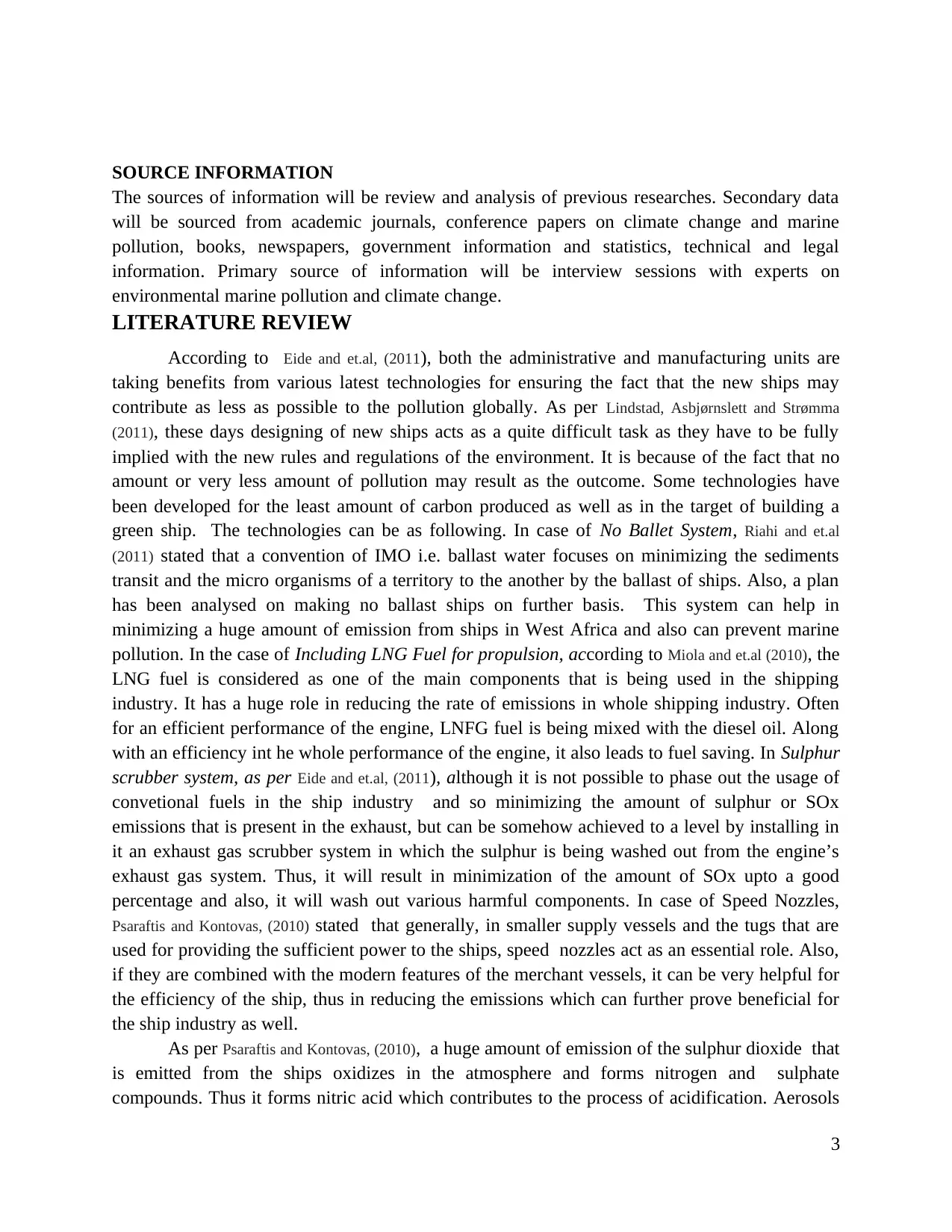
Source Information
SOURCE INFORMATION
The sources of information will be review and analysis of previous researches. Secondary data
will be sourced from academic journals, conference papers on climate change and marine
pollution, books, newspapers, government information and statistics, technical and legal
information. Primary source of information will be interview sessions with experts on
environmental marine pollution and climate change.
LITERATURE REVIEW
According to Eide and et.al, (2011), both the administrative and manufacturing units are
taking benefits from various latest technologies for ensuring the fact that the new ships may
contribute as less as possible to the pollution globally. As per Lindstad, Asbjørnslett and Strømma
(2011), these days designing of new ships acts as a quite difficult task as they have to be fully
implied with the new rules and regulations of the environment. It is because of the fact that no
amount or very less amount of pollution may result as the outcome. Some technologies have
been developed for the least amount of carbon produced as well as in the target of building a
green ship. The technologies can be as following. In case of No Ballet System, Riahi and et.al
(2011) stated that a convention of IMO i.e. ballast water focuses on minimizing the sediments
transit and the micro organisms of a territory to the another by the ballast of ships. Also, a plan
has been analysed on making no ballast ships on further basis. This system can help in
minimizing a huge amount of emission from ships in West Africa and also can prevent marine
pollution. In the case of Including LNG Fuel for propulsion, according to Miola and et.al (2010), the
LNG fuel is considered as one of the main components that is being used in the shipping
industry. It has a huge role in reducing the rate of emissions in whole shipping industry. Often
for an efficient performance of the engine, LNFG fuel is being mixed with the diesel oil. Along
with an efficiency int he whole performance of the engine, it also leads to fuel saving. In Sulphur
scrubber system, as per Eide and et.al, (2011), although it is not possible to phase out the usage of
convetional fuels in the ship industry and so minimizing the amount of sulphur or SOx
emissions that is present in the exhaust, but can be somehow achieved to a level by installing in
it an exhaust gas scrubber system in which the sulphur is being washed out from the engine’s
exhaust gas system. Thus, it will result in minimization of the amount of SOx upto a good
percentage and also, it will wash out various harmful components. In case of Speed Nozzles,
Psaraftis and Kontovas, (2010) stated that generally, in smaller supply vessels and the tugs that are
used for providing the sufficient power to the ships, speed nozzles act as an essential role. Also,
if they are combined with the modern features of the merchant vessels, it can be very helpful for
the efficiency of the ship, thus in reducing the emissions which can further prove beneficial for
the ship industry as well.
As per Psaraftis and Kontovas, (2010), a huge amount of emission of the sulphur dioxide that
is emitted from the ships oxidizes in the atmosphere and forms nitrogen and sulphate
compounds. Thus it forms nitric acid which contributes to the process of acidification. Aerosols
3
SOURCE INFORMATION
The sources of information will be review and analysis of previous researches. Secondary data
will be sourced from academic journals, conference papers on climate change and marine
pollution, books, newspapers, government information and statistics, technical and legal
information. Primary source of information will be interview sessions with experts on
environmental marine pollution and climate change.
LITERATURE REVIEW
According to Eide and et.al, (2011), both the administrative and manufacturing units are
taking benefits from various latest technologies for ensuring the fact that the new ships may
contribute as less as possible to the pollution globally. As per Lindstad, Asbjørnslett and Strømma
(2011), these days designing of new ships acts as a quite difficult task as they have to be fully
implied with the new rules and regulations of the environment. It is because of the fact that no
amount or very less amount of pollution may result as the outcome. Some technologies have
been developed for the least amount of carbon produced as well as in the target of building a
green ship. The technologies can be as following. In case of No Ballet System, Riahi and et.al
(2011) stated that a convention of IMO i.e. ballast water focuses on minimizing the sediments
transit and the micro organisms of a territory to the another by the ballast of ships. Also, a plan
has been analysed on making no ballast ships on further basis. This system can help in
minimizing a huge amount of emission from ships in West Africa and also can prevent marine
pollution. In the case of Including LNG Fuel for propulsion, according to Miola and et.al (2010), the
LNG fuel is considered as one of the main components that is being used in the shipping
industry. It has a huge role in reducing the rate of emissions in whole shipping industry. Often
for an efficient performance of the engine, LNFG fuel is being mixed with the diesel oil. Along
with an efficiency int he whole performance of the engine, it also leads to fuel saving. In Sulphur
scrubber system, as per Eide and et.al, (2011), although it is not possible to phase out the usage of
convetional fuels in the ship industry and so minimizing the amount of sulphur or SOx
emissions that is present in the exhaust, but can be somehow achieved to a level by installing in
it an exhaust gas scrubber system in which the sulphur is being washed out from the engine’s
exhaust gas system. Thus, it will result in minimization of the amount of SOx upto a good
percentage and also, it will wash out various harmful components. In case of Speed Nozzles,
Psaraftis and Kontovas, (2010) stated that generally, in smaller supply vessels and the tugs that are
used for providing the sufficient power to the ships, speed nozzles act as an essential role. Also,
if they are combined with the modern features of the merchant vessels, it can be very helpful for
the efficiency of the ship, thus in reducing the emissions which can further prove beneficial for
the ship industry as well.
As per Psaraftis and Kontovas, (2010), a huge amount of emission of the sulphur dioxide that
is emitted from the ships oxidizes in the atmosphere and forms nitrogen and sulphate
compounds. Thus it forms nitric acid which contributes to the process of acidification. Aerosols
3
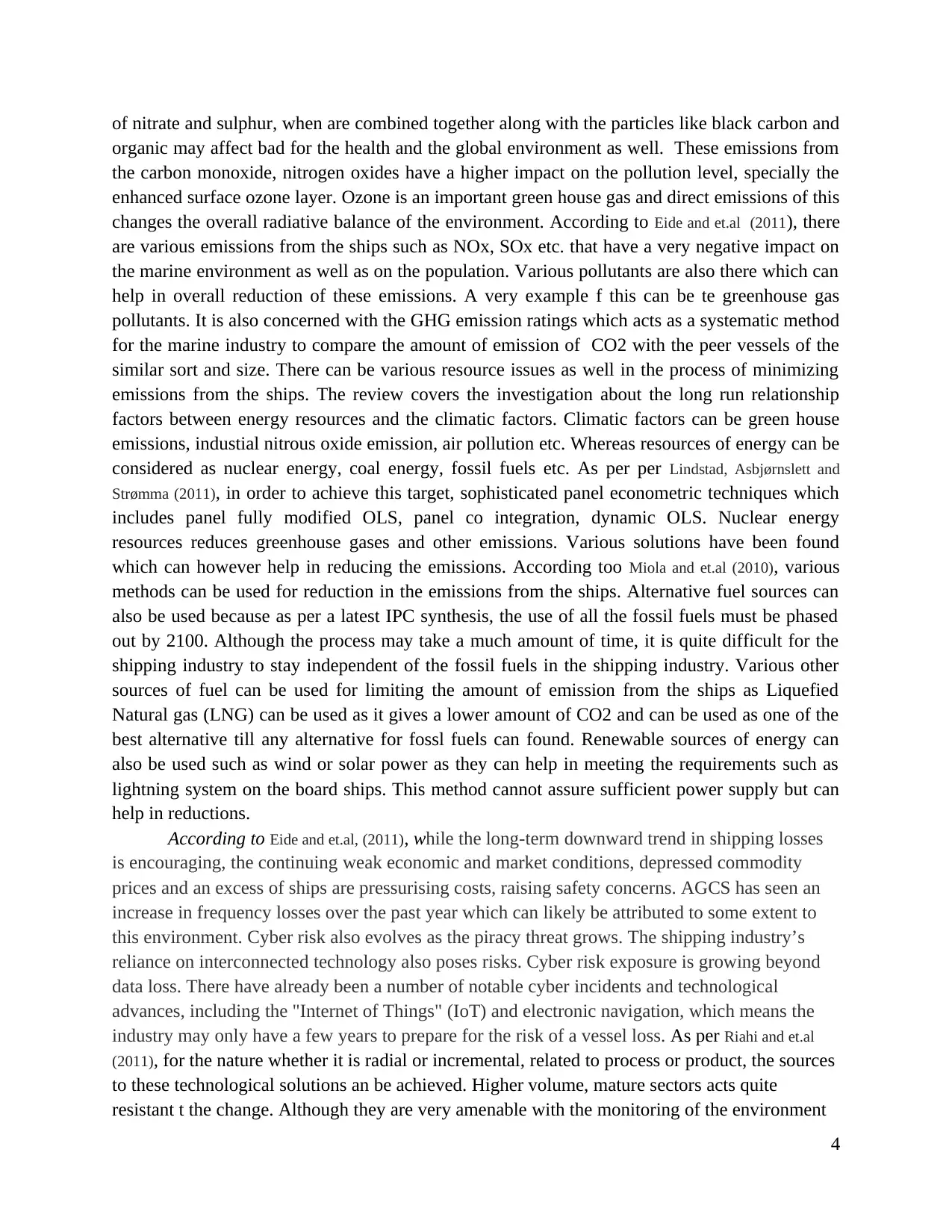
of nitrate and sulphur, when are combined together along with the particles like black carbon and
organic may affect bad for the health and the global environment as well. These emissions from
the carbon monoxide, nitrogen oxides have a higher impact on the pollution level, specially the
enhanced surface ozone layer. Ozone is an important green house gas and direct emissions of this
changes the overall radiative balance of the environment. According to Eide and et.al (2011), there
are various emissions from the ships such as NOx, SOx etc. that have a very negative impact on
the marine environment as well as on the population. Various pollutants are also there which can
help in overall reduction of these emissions. A very example f this can be te greenhouse gas
pollutants. It is also concerned with the GHG emission ratings which acts as a systematic method
for the marine industry to compare the amount of emission of CO2 with the peer vessels of the
similar sort and size. There can be various resource issues as well in the process of minimizing
emissions from the ships. The review covers the investigation about the long run relationship
factors between energy resources and the climatic factors. Climatic factors can be green house
emissions, industial nitrous oxide emission, air pollution etc. Whereas resources of energy can be
considered as nuclear energy, coal energy, fossil fuels etc. As per per Lindstad, Asbjørnslett and
Strømma (2011), in order to achieve this target, sophisticated panel econometric techniques which
includes panel fully modified OLS, panel co integration, dynamic OLS. Nuclear energy
resources reduces greenhouse gases and other emissions. Various solutions have been found
which can however help in reducing the emissions. According too Miola and et.al (2010), various
methods can be used for reduction in the emissions from the ships. Alternative fuel sources can
also be used because as per a latest IPC synthesis, the use of all the fossil fuels must be phased
out by 2100. Although the process may take a much amount of time, it is quite difficult for the
shipping industry to stay independent of the fossil fuels in the shipping industry. Various other
sources of fuel can be used for limiting the amount of emission from the ships as Liquefied
Natural gas (LNG) can be used as it gives a lower amount of CO2 and can be used as one of the
best alternative till any alternative for fossl fuels can found. Renewable sources of energy can
also be used such as wind or solar power as they can help in meeting the requirements such as
lightning system on the board ships. This method cannot assure sufficient power supply but can
help in reductions.
According to Eide and et.al, (2011), while the long-term downward trend in shipping losses
is encouraging, the continuing weak economic and market conditions, depressed commodity
prices and an excess of ships are pressurising costs, raising safety concerns. AGCS has seen an
increase in frequency losses over the past year which can likely be attributed to some extent to
this environment. Cyber risk also evolves as the piracy threat grows. The shipping industry’s
reliance on interconnected technology also poses risks. Cyber risk exposure is growing beyond
data loss. There have already been a number of notable cyber incidents and technological
advances, including the "Internet of Things" (IoT) and electronic navigation, which means the
industry may only have a few years to prepare for the risk of a vessel loss. As per Riahi and et.al
(2011), for the nature whether it is radial or incremental, related to process or product, the sources
to these technological solutions an be achieved. Higher volume, mature sectors acts quite
resistant t the change. Although they are very amenable with the monitoring of the environment
4
organic may affect bad for the health and the global environment as well. These emissions from
the carbon monoxide, nitrogen oxides have a higher impact on the pollution level, specially the
enhanced surface ozone layer. Ozone is an important green house gas and direct emissions of this
changes the overall radiative balance of the environment. According to Eide and et.al (2011), there
are various emissions from the ships such as NOx, SOx etc. that have a very negative impact on
the marine environment as well as on the population. Various pollutants are also there which can
help in overall reduction of these emissions. A very example f this can be te greenhouse gas
pollutants. It is also concerned with the GHG emission ratings which acts as a systematic method
for the marine industry to compare the amount of emission of CO2 with the peer vessels of the
similar sort and size. There can be various resource issues as well in the process of minimizing
emissions from the ships. The review covers the investigation about the long run relationship
factors between energy resources and the climatic factors. Climatic factors can be green house
emissions, industial nitrous oxide emission, air pollution etc. Whereas resources of energy can be
considered as nuclear energy, coal energy, fossil fuels etc. As per per Lindstad, Asbjørnslett and
Strømma (2011), in order to achieve this target, sophisticated panel econometric techniques which
includes panel fully modified OLS, panel co integration, dynamic OLS. Nuclear energy
resources reduces greenhouse gases and other emissions. Various solutions have been found
which can however help in reducing the emissions. According too Miola and et.al (2010), various
methods can be used for reduction in the emissions from the ships. Alternative fuel sources can
also be used because as per a latest IPC synthesis, the use of all the fossil fuels must be phased
out by 2100. Although the process may take a much amount of time, it is quite difficult for the
shipping industry to stay independent of the fossil fuels in the shipping industry. Various other
sources of fuel can be used for limiting the amount of emission from the ships as Liquefied
Natural gas (LNG) can be used as it gives a lower amount of CO2 and can be used as one of the
best alternative till any alternative for fossl fuels can found. Renewable sources of energy can
also be used such as wind or solar power as they can help in meeting the requirements such as
lightning system on the board ships. This method cannot assure sufficient power supply but can
help in reductions.
According to Eide and et.al, (2011), while the long-term downward trend in shipping losses
is encouraging, the continuing weak economic and market conditions, depressed commodity
prices and an excess of ships are pressurising costs, raising safety concerns. AGCS has seen an
increase in frequency losses over the past year which can likely be attributed to some extent to
this environment. Cyber risk also evolves as the piracy threat grows. The shipping industry’s
reliance on interconnected technology also poses risks. Cyber risk exposure is growing beyond
data loss. There have already been a number of notable cyber incidents and technological
advances, including the "Internet of Things" (IoT) and electronic navigation, which means the
industry may only have a few years to prepare for the risk of a vessel loss. As per Riahi and et.al
(2011), for the nature whether it is radial or incremental, related to process or product, the sources
to these technological solutions an be achieved. Higher volume, mature sectors acts quite
resistant t the change. Although they are very amenable with the monitoring of the environment
4
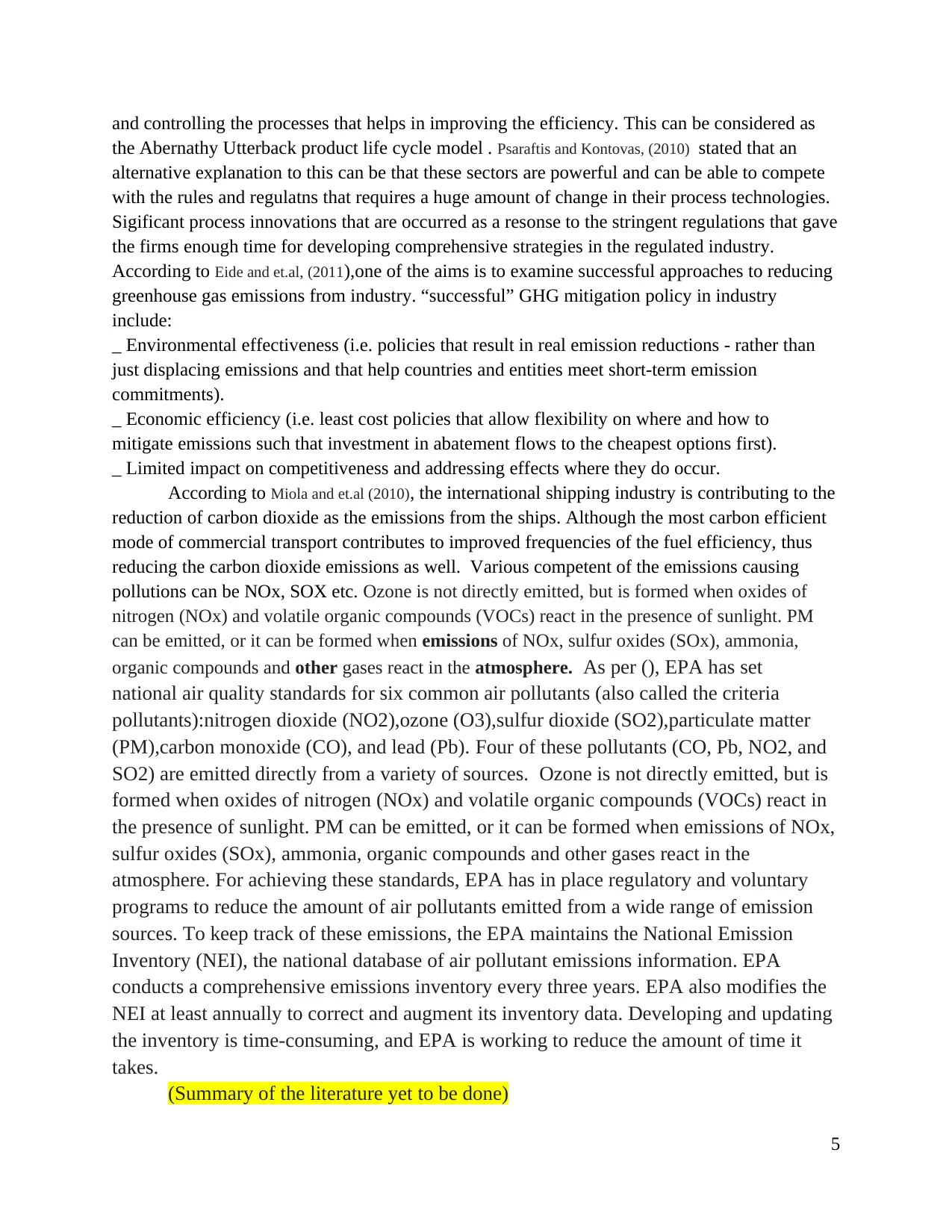
and controlling the processes that helps in improving the efficiency. This can be considered as
the Abernathy Utterback product life cycle model . Psaraftis and Kontovas, (2010) stated that an
alternative explanation to this can be that these sectors are powerful and can be able to compete
with the rules and regulatns that requires a huge amount of change in their process technologies.
Sigificant process innovations that are occurred as a resonse to the stringent regulations that gave
the firms enough time for developing comprehensive strategies in the regulated industry.
According to Eide and et.al, (2011),one of the aims is to examine successful approaches to reducing
greenhouse gas emissions from industry. “successful” GHG mitigation policy in industry
include:
_ Environmental effectiveness (i.e. policies that result in real emission reductions - rather than
just displacing emissions and that help countries and entities meet short-term emission
commitments).
_ Economic efficiency (i.e. least cost policies that allow flexibility on where and how to
mitigate emissions such that investment in abatement flows to the cheapest options first).
_ Limited impact on competitiveness and addressing effects where they do occur.
According to Miola and et.al (2010), the international shipping industry is contributing to the
reduction of carbon dioxide as the emissions from the ships. Although the most carbon efficient
mode of commercial transport contributes to improved frequencies of the fuel efficiency, thus
reducing the carbon dioxide emissions as well. Various competent of the emissions causing
pollutions can be NOx, SOX etc. Ozone is not directly emitted, but is formed when oxides of
nitrogen (NOx) and volatile organic compounds (VOCs) react in the presence of sunlight. PM
can be emitted, or it can be formed when emissions of NOx, sulfur oxides (SOx), ammonia,
organic compounds and other gases react in the atmosphere. As per (), EPA has set
national air quality standards for six common air pollutants (also called the criteria
pollutants):nitrogen dioxide (NO2),ozone (O3),sulfur dioxide (SO2),particulate matter
(PM),carbon monoxide (CO), and lead (Pb). Four of these pollutants (CO, Pb, NO2, and
SO2) are emitted directly from a variety of sources. Ozone is not directly emitted, but is
formed when oxides of nitrogen (NOx) and volatile organic compounds (VOCs) react in
the presence of sunlight. PM can be emitted, or it can be formed when emissions of NOx,
sulfur oxides (SOx), ammonia, organic compounds and other gases react in the
atmosphere. For achieving these standards, EPA has in place regulatory and voluntary
programs to reduce the amount of air pollutants emitted from a wide range of emission
sources. To keep track of these emissions, the EPA maintains the National Emission
Inventory (NEI), the national database of air pollutant emissions information. EPA
conducts a comprehensive emissions inventory every three years. EPA also modifies the
NEI at least annually to correct and augment its inventory data. Developing and updating
the inventory is time-consuming, and EPA is working to reduce the amount of time it
takes.
(Summary of the literature yet to be done)
5
the Abernathy Utterback product life cycle model . Psaraftis and Kontovas, (2010) stated that an
alternative explanation to this can be that these sectors are powerful and can be able to compete
with the rules and regulatns that requires a huge amount of change in their process technologies.
Sigificant process innovations that are occurred as a resonse to the stringent regulations that gave
the firms enough time for developing comprehensive strategies in the regulated industry.
According to Eide and et.al, (2011),one of the aims is to examine successful approaches to reducing
greenhouse gas emissions from industry. “successful” GHG mitigation policy in industry
include:
_ Environmental effectiveness (i.e. policies that result in real emission reductions - rather than
just displacing emissions and that help countries and entities meet short-term emission
commitments).
_ Economic efficiency (i.e. least cost policies that allow flexibility on where and how to
mitigate emissions such that investment in abatement flows to the cheapest options first).
_ Limited impact on competitiveness and addressing effects where they do occur.
According to Miola and et.al (2010), the international shipping industry is contributing to the
reduction of carbon dioxide as the emissions from the ships. Although the most carbon efficient
mode of commercial transport contributes to improved frequencies of the fuel efficiency, thus
reducing the carbon dioxide emissions as well. Various competent of the emissions causing
pollutions can be NOx, SOX etc. Ozone is not directly emitted, but is formed when oxides of
nitrogen (NOx) and volatile organic compounds (VOCs) react in the presence of sunlight. PM
can be emitted, or it can be formed when emissions of NOx, sulfur oxides (SOx), ammonia,
organic compounds and other gases react in the atmosphere. As per (), EPA has set
national air quality standards for six common air pollutants (also called the criteria
pollutants):nitrogen dioxide (NO2),ozone (O3),sulfur dioxide (SO2),particulate matter
(PM),carbon monoxide (CO), and lead (Pb). Four of these pollutants (CO, Pb, NO2, and
SO2) are emitted directly from a variety of sources. Ozone is not directly emitted, but is
formed when oxides of nitrogen (NOx) and volatile organic compounds (VOCs) react in
the presence of sunlight. PM can be emitted, or it can be formed when emissions of NOx,
sulfur oxides (SOx), ammonia, organic compounds and other gases react in the
atmosphere. For achieving these standards, EPA has in place regulatory and voluntary
programs to reduce the amount of air pollutants emitted from a wide range of emission
sources. To keep track of these emissions, the EPA maintains the National Emission
Inventory (NEI), the national database of air pollutant emissions information. EPA
conducts a comprehensive emissions inventory every three years. EPA also modifies the
NEI at least annually to correct and augment its inventory data. Developing and updating
the inventory is time-consuming, and EPA is working to reduce the amount of time it
takes.
(Summary of the literature yet to be done)
5
Paraphrase This Document
Need a fresh take? Get an instant paraphrase of this document with our AI Paraphraser

6
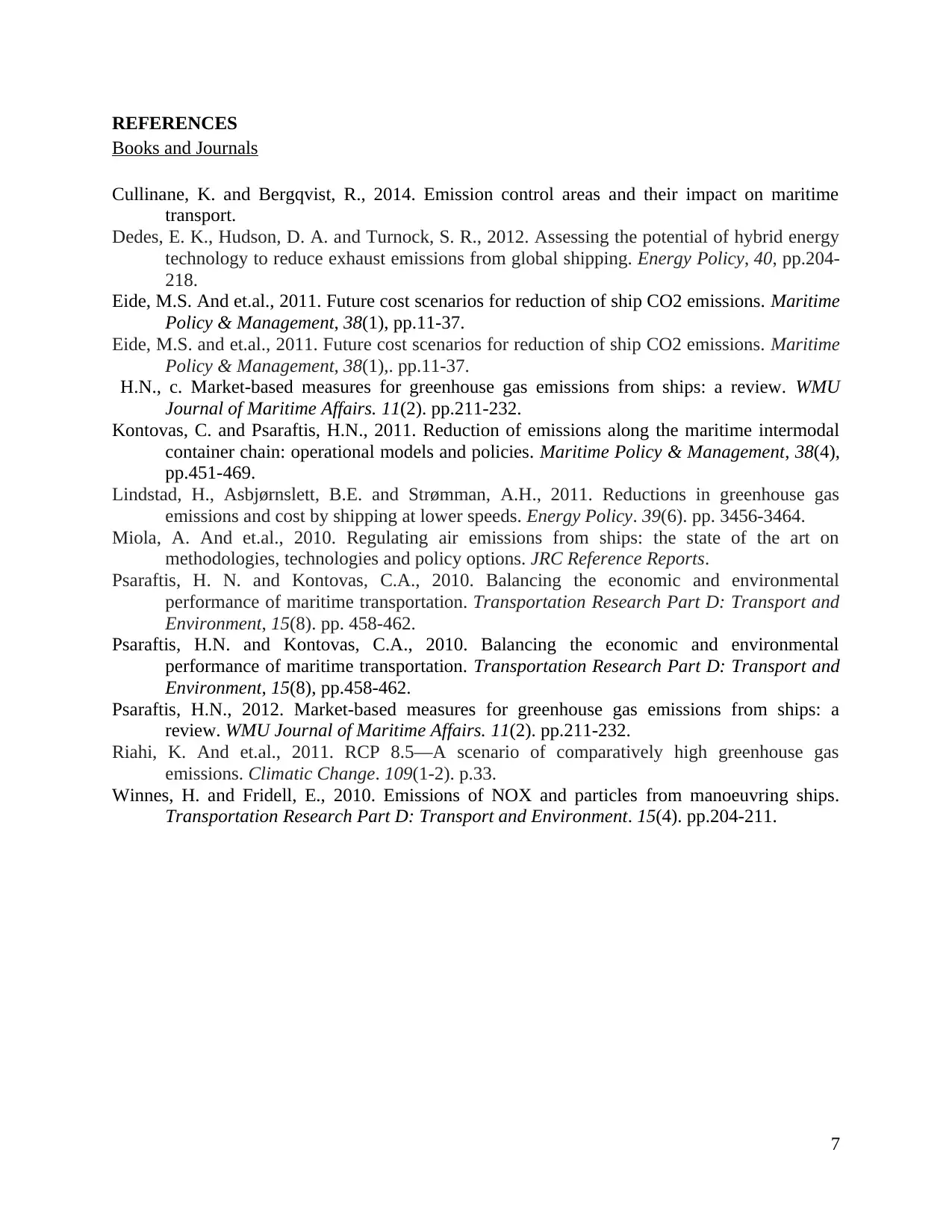
REFERENCES
Books and Journals
Cullinane, K. and Bergqvist, R., 2014. Emission control areas and their impact on maritime
transport.
Dedes, E. K., Hudson, D. A. and Turnock, S. R., 2012. Assessing the potential of hybrid energy
technology to reduce exhaust emissions from global shipping. Energy Policy, 40, pp.204-
218.
Eide, M.S. And et.al., 2011. Future cost scenarios for reduction of ship CO2 emissions. Maritime
Policy & Management, 38(1), pp.11-37.
Eide, M.S. and et.al., 2011. Future cost scenarios for reduction of ship CO2 emissions. Maritime
Policy & Management, 38(1),. pp.11-37.
H.N., c. Market-based measures for greenhouse gas emissions from ships: a review. WMU
Journal of Maritime Affairs. 11(2). pp.211-232.
Kontovas, C. and Psaraftis, H.N., 2011. Reduction of emissions along the maritime intermodal
container chain: operational models and policies. Maritime Policy & Management, 38(4),
pp.451-469.
Lindstad, H., Asbjørnslett, B.E. and Strømman, A.H., 2011. Reductions in greenhouse gas
emissions and cost by shipping at lower speeds. Energy Policy. 39(6). pp. 3456-3464.
Miola, A. And et.al., 2010. Regulating air emissions from ships: the state of the art on
methodologies, technologies and policy options. JRC Reference Reports.
Psaraftis, H. N. and Kontovas, C.A., 2010. Balancing the economic and environmental
performance of maritime transportation. Transportation Research Part D: Transport and
Environment, 15(8). pp. 458-462.
Psaraftis, H.N. and Kontovas, C.A., 2010. Balancing the economic and environmental
performance of maritime transportation. Transportation Research Part D: Transport and
Environment, 15(8), pp.458-462.
Psaraftis, H.N., 2012. Market-based measures for greenhouse gas emissions from ships: a
review. WMU Journal of Maritime Affairs. 11(2). pp.211-232.
Riahi, K. And et.al., 2011. RCP 8.5—A scenario of comparatively high greenhouse gas
emissions. Climatic Change. 109(1-2). p.33.
Winnes, H. and Fridell, E., 2010. Emissions of NOX and particles from manoeuvring ships.
Transportation Research Part D: Transport and Environment. 15(4). pp.204-211.
7
Books and Journals
Cullinane, K. and Bergqvist, R., 2014. Emission control areas and their impact on maritime
transport.
Dedes, E. K., Hudson, D. A. and Turnock, S. R., 2012. Assessing the potential of hybrid energy
technology to reduce exhaust emissions from global shipping. Energy Policy, 40, pp.204-
218.
Eide, M.S. And et.al., 2011. Future cost scenarios for reduction of ship CO2 emissions. Maritime
Policy & Management, 38(1), pp.11-37.
Eide, M.S. and et.al., 2011. Future cost scenarios for reduction of ship CO2 emissions. Maritime
Policy & Management, 38(1),. pp.11-37.
H.N., c. Market-based measures for greenhouse gas emissions from ships: a review. WMU
Journal of Maritime Affairs. 11(2). pp.211-232.
Kontovas, C. and Psaraftis, H.N., 2011. Reduction of emissions along the maritime intermodal
container chain: operational models and policies. Maritime Policy & Management, 38(4),
pp.451-469.
Lindstad, H., Asbjørnslett, B.E. and Strømman, A.H., 2011. Reductions in greenhouse gas
emissions and cost by shipping at lower speeds. Energy Policy. 39(6). pp. 3456-3464.
Miola, A. And et.al., 2010. Regulating air emissions from ships: the state of the art on
methodologies, technologies and policy options. JRC Reference Reports.
Psaraftis, H. N. and Kontovas, C.A., 2010. Balancing the economic and environmental
performance of maritime transportation. Transportation Research Part D: Transport and
Environment, 15(8). pp. 458-462.
Psaraftis, H.N. and Kontovas, C.A., 2010. Balancing the economic and environmental
performance of maritime transportation. Transportation Research Part D: Transport and
Environment, 15(8), pp.458-462.
Psaraftis, H.N., 2012. Market-based measures for greenhouse gas emissions from ships: a
review. WMU Journal of Maritime Affairs. 11(2). pp.211-232.
Riahi, K. And et.al., 2011. RCP 8.5—A scenario of comparatively high greenhouse gas
emissions. Climatic Change. 109(1-2). p.33.
Winnes, H. and Fridell, E., 2010. Emissions of NOX and particles from manoeuvring ships.
Transportation Research Part D: Transport and Environment. 15(4). pp.204-211.
7
1 out of 9
Related Documents
Your All-in-One AI-Powered Toolkit for Academic Success.
+13062052269
info@desklib.com
Available 24*7 on WhatsApp / Email
![[object Object]](/_next/static/media/star-bottom.7253800d.svg)
Unlock your academic potential
© 2024 | Zucol Services PVT LTD | All rights reserved.





